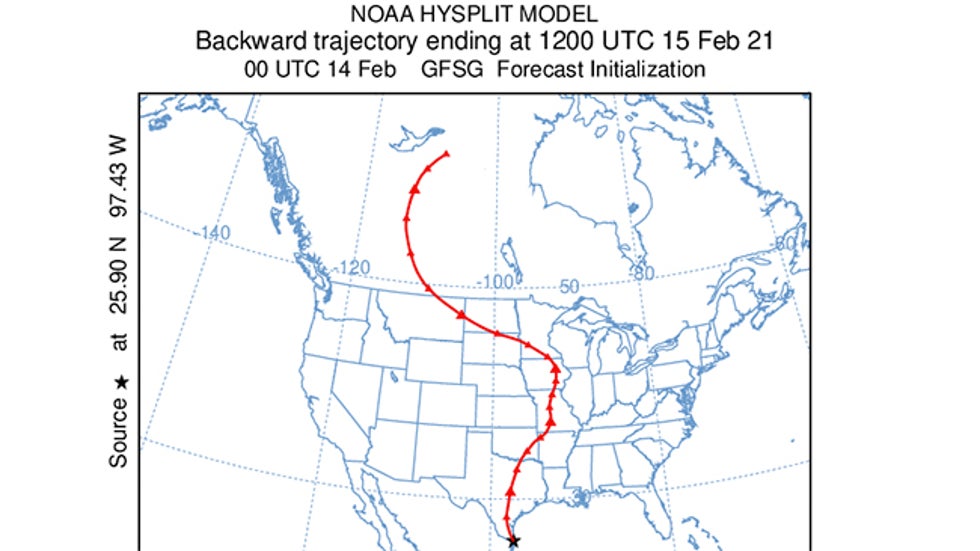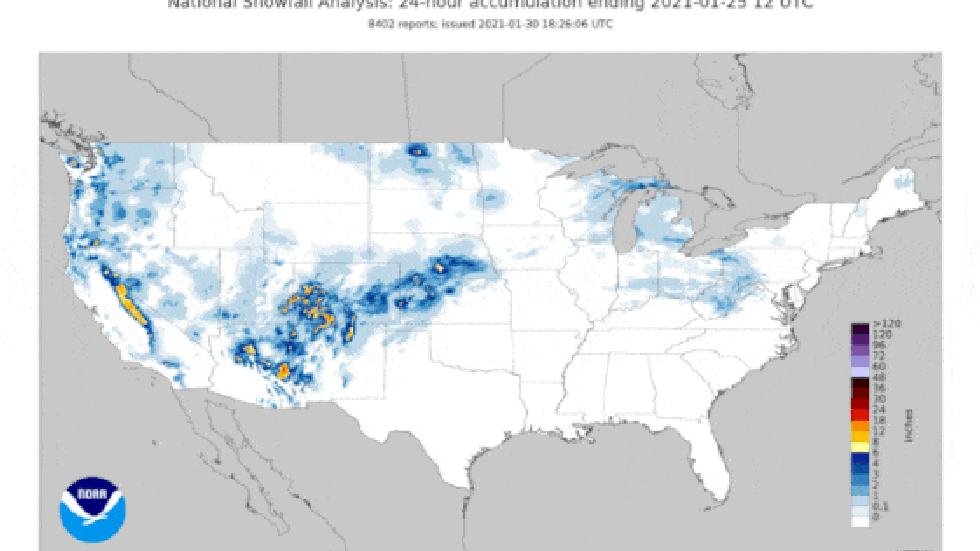Jonathan Erdman
A siege of winter storms and bitter cold over the past few weeks smashed thousands of temperature records from the Canadian border to South Texas and delivered multiple rounds of snow and ice to the West, South, Midwest and Northeast.
With Winter Storm Viola now over and a slow warm up finally underway, the weather pattern is finally giving the U.S. a well-deserved breather after a frenetic stretch of snow, ice and cold.
(MORE: Texas Slowly Recovering From Cold and Snow)
Let's put into context what we've just ridden out, starting with the recent severe cold outbreak.
Over 6,000 Cold Records
From Feb. 7-16, there were 6,601 daily cold records tied or set according to preliminary data from NOAA. These are for a particular calendar day, including both daily cold high and low temperatures from locations with at least a 30-year history or data.
The bitter cold ramped up in earnest beginning on Feb. 7 and peaked in the days before and after Valentine's Day.
There were 944 daily record cold highs on Feb. 14, alone, and 567 daily record cold lows on the following day, Feb. 15.
 The number of preliminary daily cold temperature records tied or set in the U.S. including daily record cold highs (light blue bars) and daily cold lows (purple bars) from Feb. 7-16, 2021.
The number of preliminary daily cold temperature records tied or set in the U.S. including daily record cold highs (light blue bars) and daily cold lows (purple bars) from Feb. 7-16, 2021.NOAA found 30% of all U.S. reporting stations set record daily cold highs and 20% set record daily cold lows from Feb. 14-16.
By contrast, during that same 10-day period ending Feb. 16 only 251 warm records were tied or set, only 1 warm record for every 26 cold records.
All-Time Records
As impressive as those tallies were, there were also dozens of locations that set records not just for a particular calendar day, but rather for any day in their history.
Eighty all-time coldest daily high temperature records were tied or set from Feb. 14-16.
Topping that were 50 all-time coldest low temperature records in 11 different states from Feb. 11-16, according to NOAA.
 Locations that tied or set new all-time record lows from Feb. 11-16, 2021.
Locations that tied or set new all-time record lows from Feb. 11-16, 2021.Leading the way was Bottineau, North Dakota.
SPONSORED: Major winter sale at Columbia Sportswear
This town only 10 miles from the Canadian border recorded an air temperature - not wind chill - of minus 51 degrees on Feb. 13, toppling their previous all-time low of minus 50 degrees which had stood for 128 years, since Benjamin Harrison was finishing up his term as President in 1893.
Among the other notable all-time lows were Owen, Wisconsin (minus 45 degrees); Spearfish, South Dakota (minus 33 degrees); Sioux City, Iowa (minus 28 degrees; a tie); Lawton, Oklahoma (minus 12 degrees); and Tyler, Texas (minus 6 degrees).
Temperatures as cold as minus 20 degrees were recorded as far south as the Texas Panhandle and Arkansas.
NOAA's Weather Prediction Center noted temperatures during the peak of the cold outbreak were as much as 40 to 50 degrees colder than average for mid-February.
This cold outbreak was also the first time the National Weather Service's Houston/Galveston forecast office issued a wind chill warning, during which Hobby Airport's wind chill bottomed out at 1 degree, according to NOAA meteorologist Alex Lamers.
The ferocity of this cold air had a connection to Siberia.
"Air from Siberia flowed across the North Pole and made a beeline south from Canada all the way down to the Gulf Coast as an arctic high pressure system set up shop right over the heart of the nation," said winter weather expert Tom Niziol, in an email to weather.com.
Niziol said a back-trajectory model used to find the origin of warm and cold air masses indicated the arctic air that pushed into South Texas travelled from near Yellowknife, in Canada's Northwest Territories in five days.
 NOAA's HYSPLIT model run from 0z on Feb. 14, 2021, showing the origin of arctic air that arrived in South Texas was from Canada's Northwest Territories.
NOAA's HYSPLIT model run from 0z on Feb. 14, 2021, showing the origin of arctic air that arrived in South Texas was from Canada's Northwest Territories.Despite these all-time records, the coldest temperatures in this event still fell well short of the February 1899 outbreak, considered the all-time cold outbreak in the Plains, according to Brian Brettschneider, an Alaska-based climatologist.
While Dallas-Ft. Worth (minus 2 degrees) and Oklahoma City (minus 14 degrees) plunged well below zero, each city fell short of their Feb. 1899 outbreak records of minus 8 and minus 17 degrees, respectively.
Long-Lasting Cold
The cold outbreak's longevity was also impressive.
Oklahoma City set its longest stretch below 20 degrees of roughly one week straight, according to Lamers. Their average low temperature in mid-February is 34 degrees.
Lamers also noted Wichita, Kansas, spent 10 straight days colder than 20 degrees, while Kansas City spent 11 straight days without rising above 15 degrees.
Billings, Montana, and Fargo, North Dakota, shivered through their longest subzero streaks since 1983 and 1996, respectively.
Winter Storm Siege
The cold outbreak punctuated an active procession of winter storms since late January.
From Jan. 24 through Feb. 19, nine separate storms met The Weather Channel's criteria for a named winter storm, based on population (at least 2 million) and/or areal coverage (at least 400,000 square kilometers) of National Weather Service winter warnings.
 This is an animation of 24-hour snow accumulations each day from Jan. 24 - Feb. 18, 2021, illustrating the procession of winter storms across the nation.
This is an animation of 24-hour snow accumulations each day from Jan. 24 - Feb. 18, 2021, illustrating the procession of winter storms across the nation.This hectic string culminated in a barrage of four storms - Shirley, Tabitha, Uri and Viola - from Feb. 11-19.
Multiple ice storms affected parts of Virginia, North Carolina and Oregon.
And, of course, we had the back-to-back South winter storms, Uri then Viola, within a couple days of each other after Valentine's Day.
Abilene and San Angelo, Texas, set all-time snow records.
It was the first time on record Little Rock, Arkansas, had two calendar-day 6-inch-plus snowfalls in the same winter season, much less in the same week. Parts of Arkansas picked up over 20 inches of snow from both storms, combined.
Even the tail end of the last of these storms set an all-time record calendar-day snow - 11.2 inches - in Del Rio, Texas, on Feb. 18.
(MORE: The Most Snow Fatigued Cities Right Now)
This resulted in the most widespread snow cover in the Lower 48 states in at least 17 years.
But, this parade of winter storms wasn't just a South story.
Chicago had its snowiest stretch since January 1979.
Both Seattle and Portland had their heaviest two-day snowfalls since the Vietnam War.
Winter Storm Orlena may have shattered a New Jersey state snowfall record to kick off February.
And to think the spring equinox is still a month away.
The Weather Company’s primary journalistic mission is to report on breaking weather news, the environment and the importance of science to our lives. This story does not necessarily represent the position of our parent company, IBM.
The Weather Company’s primary journalistic mission is to report on breaking weather news, the environment and the importance of science to our lives. This story does not necessarily represent the position of our parent company, IBM.

No comments:
Post a Comment